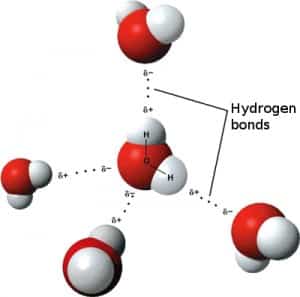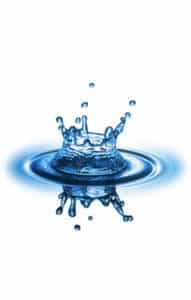- Water is a unique substance essential to life.
- It is the most abundant molecule in any cell.
- The human body is 55-78% composed of water.
1. Polar Molecule – A polar covalent bond is formed between oxygen and hydrogen. The oxygen atom is slightly negative and the hydrogen  is slightly positive due to unequal sharing of the electron.
is slightly positive due to unequal sharing of the electron.
2. Hydrogen bonds – weak attractions between the polar ends of water molecules. (not true “bonds”). Covalent bonds between hydrogen and oxygen atoms are stronger than hydrogen bonds.
3. Cohesion – intermolecular force between water molecules; because of H-bonds, the molecules tend to “stick” together resulting in high surface tension (a measure of how difficult it is to break the surface of a liquid). This is why insects can walk on water and plants can move water up from their roots to their leaves through transpiration.
- Water does not interact with nonpolar substances. Wax is a nonpolar substance, thus water molecules are only being pulled toward each other, forming a sphere. Office paper has a coating which is more polar than wax, but less polar than paper towels. This results in dome-shaped drop. Paper towels are more polar than office paper, thus paper towels actually break the surface tension of water to absorb it.
Adhesion –intermolecular force between a water molecule and other molecules.
Capillary Action – water flowing in plants against gravity upward from roots to leaves. Possible, due to cohesion between water molecules in the root and adhesion between a water molecule and cellulose in the xylem (plant cell wall). Water moves from root to leaves to evaporate.
4. High specific heat capacity (the amount of energy needed to raise 1g of liquid 1 oC) – it takes a lot of energy to change the temperature of water (to break all those H-bonds.)
Due to the high specific heat capacity, the water that covers the Earth’s surface keeps temperature fluctuations within limits that allow living organisms to survive. Organisms consist mostly of water so they are more able to resist changes in their own temperatures.
Coastal areas will have a more moderate temperature than inland areas.
5. Liquid Temperature Range – Due to the cohesion force between water molecules, water remains liquid over a wide temperature range (0 – 100 oC). Since it takes a lot of energy to break the hydrogen bonds water has high melting and boiling point. This property of water makes it possible for a wide variety of aquatic habitats (near freezing to hot springs).
6. Density – solid water is less dense than liquid water (water expands as it solidifies). Ice has a relatively open structure – more space between the molecules. Ponds freeze from the top down allowing life to continue underneath the ice.
7. Good Solvent – almost anything dissolves readily in water. This property allows your blood to carry nutrients, gases, and waste (blood is 50% water).
8. Transparent – Light penetrates water therefore aquatic plants can survive.
9. Coolant – when we are hot, we sweat. The water evaporates, cooling our bodies.

thanks